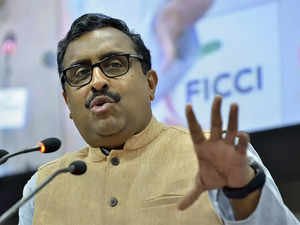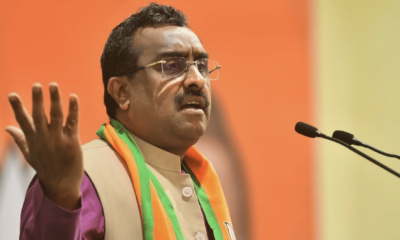
|
Getting your Trinity Audio player ready...
|
Galwan is very unfortunate. But India will continue to engage with Chinadiplomatically and militarily, says BJP general secretary Ram Madhav in an interaction with Vasudha Venugopal. Excerpts
On Sino-Indian Relationship
We attempted cordial relationship with China, after the initial troubles in 2014 in Chumar. But we had Doklam in 2017, which too we sorted out. But the recent Galwan incident where our soldiers were killed is a very unfortunate landmark. Because after 1975, this is the first occasion we have had casualties. Till now, we have had border violations and standoffs, but no casualties on the spot. This incident will impact China negatively. After 1962, efforts have been made from both sides to reduce the antipathy against the Chinese. Prime Minister Narendra Modi tried very hard to keep the equation on an even keel, and send across a message to the common man that things can be worked out with China. But now all those efforts get pushed back by many years. So, in that sense, China will be the biggest loser in terms of public perception in India. As far as India is concerned, we will continue to engage with China diplomatically and militarily. The brutality and barbarism that the Chinese army showed with our soldiers has caused a lot of resentment in Indian minds.
Future Confrontations
India does not want any future confrontations to occur. If you go by the official statements of the Chinese foreign ministry officials, we hear the same thing. But past experiences with China have not been great. We can’t let our guard down, as despite our best efforts we have seen violations, in 2014 and in Doklam, and now, in 2020 in Galwan. So, definitely, India has to be watchful, on alert all the time with regard to China.
Galwan Dispute
One has to be clear that what we call the LAC or the Line of Actual control is not a demarcated line but a claimed line of territory, upon which there is no general agreement. However, over the years, there have been 20 rounds of negotiations between the two parties due to which large parts of the LAC have been agreed upon. But there are enough spots where we don’t have an agreement, where both sides patrol. Areas like Galwan valley fall under that category, where there is no agreement on the demarcated line or perceived LAC. The confusion arises when you equate the LAC with the LOC, which is a demarcated line.
India’s Reading of China
In fact, it is because we read China right that we are being able to physically stall them now. That was never the case earlier. Since 1988 when Rajiv Gandhi as PM visited China after 1962, there have been many PMs who have signed six agreements, indulged in several negotiations in the hope that peace will prevail. When we last signed an agreement with the Chinese in 2013, their soldiers had already intruded into our land, almost 19 Kms. They pitched tents, and we did nothing. PM Narendra Modi has taken these acts of aggressions very seriously, and talked directly with Chinese President Xi Jinping. That is how things de-escalated. Now, it is not only about dialogue and negotiations, but also about strong ground posturing. In 2015 we removed their posts in disputed areas. During Doklam, we mobilised troops in large numbers, preventing them from pushing the tri-junction downwards. They asked us to withdraw, we didn’t, until they removed the construction equipment. Our approach is not just dialogue and negotiations alone. It is also about strong ground posturing. We are standing very firm on the ground. What is happening at Galwan is because of this different approach.
Asymmetry of power between India and China
Warfare is different now. If you take merely the numbers, the defence spending of the US is 10 times more than China, but can we say there is asymmetry between them. Asymmetry in the 21st century is not about numbers, but about capability. There are countries that have satellites, but there are also countries with superior ground-based laser technology to jam them; missiles that turn military assets of the enemy into wasted assets. Capability is not necessarily in military terms alone. No one is talking about war here, but India is capable of taking challenges head on.
Boycott of Chinese goods
Atmanirbhar is reducing our dependence on imports. We have already started regulating investments and imports including from the neighbourhood countries like China. We are strengthening our economic base. But there is a strong anti-China sentiment among the people of India today. Not just in India, but according to a Pew Research report, the anti-China sentiment is growing across the world. What happened in Ladakh has fortified the sentiment in India.
Rahul Gandhi’s “Surender Modi” comment
PM Narendra Modi’s statement was deliberately misquoted and misinterpreted to cause confusion in the minds of many people in India. They have only helped China by giving it a handle. The PM was responding to a particular concern raised by leaders in the opposition, and his response was limited to Galwan valley. Those who played on it are harming India’s long term strategic interest. It doesn’t harm us politically, as we are sure the people of the country are with us.
Opposition’s allegation that Indian government was in denial.
From the PM to Defence Minister to EAM to army chief, everyone in this government has come forward to speak. This was not what happened in 2013 when the Chinese were camping on our territory for several days, and all that the UPA government was doing was conduct secret negotiations. FM Salman Khurshid used to only say ‘have faith in us.’ Manmohan Singh gave benefit of doubt to China. The country was never informed of what the situation was, what was agreed upon. On the contrary we are now giving out regular official positions and also fighting on the ground.
(The interview was conducted by ms Vasudha Venugopal of Economic Times on June 22, 2020. Views expressed are personal.)



